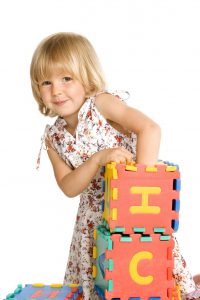What You Need To Know About Early Literacy
 Early literacy is what children know about reading and writing before they actually begin to read or write. Research indicates that their experiences in the first three years is laying the building blocks for their language, reading and writing development.
Parents and early childhood teachers play a critical role when it comes to literacy development. When considering child care providers for your child, look for media rich environments and access to materials that support drawing, writing and creating. Talk to your child’s care taker to see if they have opportunities to listen to music or sing during the day, and how often they are read to by an adult. Reading aloud is one of the most important activities that parents and teachers can do with children, and should be doing consistently and often. More words, more words, more words!
Early literacy is what children know about reading and writing before they actually begin to read or write. Research indicates that their experiences in the first three years is laying the building blocks for their language, reading and writing development.
Parents and early childhood teachers play a critical role when it comes to literacy development. When considering child care providers for your child, look for media rich environments and access to materials that support drawing, writing and creating. Talk to your child’s care taker to see if they have opportunities to listen to music or sing during the day, and how often they are read to by an adult. Reading aloud is one of the most important activities that parents and teachers can do with children, and should be doing consistently and often. More words, more words, more words!
Reading aloud has many benefits:
[su_list icon="icon: angle-right"]
- It introduces children to new vocabulary words.
- It builds many important foundational skills.
- It provides an example of fluent and expressive reading.
- It boosts conversational skills.
- It increases phonological awareness.
- It teaches them that reading can be for enjoyment.
[/su_list]
Support your child's literacy development:
[su_list icon="icon: angle-right"]
- Offer to be your child’s class “librarian” by working with the teacher to select a series of appropriate-aged books to check out from the library each month.
- Introduce your child to the library and book stores at an early age; attend the free story times offered and participate in reading challenges.
- Ask your child’s teacher if you and other parents could be guest readers in the class each month.
- Purchase new books for your child’s classroom and at home.
- Read to your child every day, even if she was read to by another adult or sibling during the day.
- Encourage your child to sing along to music and to remember nursery rhymes.
[/su_list]
BIRTH TO 1
[su_list icon="icon: angle-right"]
- Show your baby pictures in books. Describe the colors, objects, and meanings.
- Ask your child care provider for the lyrics to the nursery rhymes they sing. Repeat them at home for reinforcement.
- Encourage your child to use simple gestures, like shaking her head "no" or waving "bye-bye."
- Repeat vowel sounds like "ba" "ma" and "da." Make eye contact and imitate their expressions.
- The more words your baby is exposed to the better. Talk to them about your day, the weather outside or anything else that comes to mind.
[/su_list]
AGE 1 TO 2
[su_list icon="icon: angle-right"]
- Your child is pointing at pictures and engaging during story time. Ask your provider which books and songs your child likes best at child care, and talk to your child about them.
- Read books daily. Make story time a part of your nightly routine. Allow your child to turn the pages, touch the words and pictures.
- Sing the alphabet song on your way to school together.
- Keep books throughout the house and make a comfortable reading area with pillows and cover just for your child.
- Read a variety of books to your little one, especially poetry that rhymes.
[/su_list]
AGE 2 TO 3
[su_list icon="icon: angle-right"]
- Teach your child a “letter of the week.” Use chalk to write it on the driveway, paint it on paper, circle it in magazines, etc.
- Read their favorite book over and over again. Read it with an accent, read it wearing costumes, or even sing it!
- Have your child point out the letters she recognizes while grocery shopping or on signs as you drive.
- Read slow enough to allow your child to build mental pictures.
- Ask your child to pick out a book and a place for story time. Grant his wishes.
[/su_list]
AGE 3 TO 4
[su_list icon="icon: angle-right"]
- Make flash cards with pictures to assist your child with learning new words.
- Read a story and have your child retell the story back to you.
- During bath time have your child tell a story using their bath toys.
- When reading, use lots of expressions, change your tone of voice, and adjust your pace to fit the story.
- Check your local library and bookstore websites to find reading events, author visits and other fun outings where you can take your child.
[/su_list]
AGE 4 TO 5
[su_list icon="icon: angle-right"]
- Ask your child about the book they read at school today. Ask them to tell you about the characters.
- After reading a story, ask your child to point out common words such as: up, and, go, run, or stop.
- Work with your child to make up a story, then write it down.
- Allow your preschooler to scribble letters without correction.
- Point out common words at the grocery store, on cereal boxes, and road signs when driving.
[/su_list]
Need More Information? Reading Rockets Early Literacy Development Get Ready to Read: Building Literacy Every Day NAEYC: Great Books to Read to Infants and Toddlers





